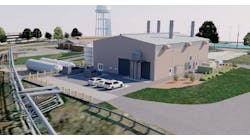In this week’s Industry Perspectives, Sally Jacquemin, Software Solutions Manager, Siemens Digital Grid, shares a ‘tale of two power outages,’ and explains how utilities can do more with less using an advanced distribution management system.
Sally Jacquemin, Software Solutions Manager, Siemens Digital Grid
Today’s distribution grid is characterized by evolving complexity. More and more resources are being added to the grid creating cost, reliability, and safety challenges. How can utilities better manage this complexity, especially at a time when they are being asked to do more with fewer resources? Advanced Distribution Management System (ADMS) software offers a one-stop shop to make it easier for utility management of distribution networks.
A tale of two power outages
This is the story of what happens on Main Street, USA when a power outage occurs – with and without an ADMS in place at the utility control center.
Tale 1: The same old story
A tree falls on a distribution line, knocking out power not only on Main Street, but also to a 50-square mile radius of surrounding rural area. The utility does not know where the tree limb came down – or even that it’s a fallen line causing the outage. It only knows that the call center is inundated with customer outage calls.
[clickToTweet tweet=”ADMS software offers a one-stop shop to make it easier for utility management of distribution networks. ” quote=”ADMS software offers a one-stop shop to make it easier for utility management of distribution networks. “]
The utility sends out crews which begin the long process of patrolling the network. The crews are working with limited information – only what they learned from the outage calls – as they try to locate the source of the problem. The guesswork could take hours.
They finally see the fallen tree. Fixing the line will take more time since the crew needs to call for more assistance. Back in the office, the operations personnel are evaluating maps and trying to determine if a plan can be generated to reconfigure the grid network to redirect some of the customers while repairs are being made. However, lacking real-time network telemetry data, they must rely on historical data that may be days or even months old.
Finally, the line is repaired, but the amount of time it took will reflect poorly in the utility’s annual performance review at the public utilities commission. Financial penalties are possible, on top of the expense incurred in sending multiple trucks to the scene for switching. Add to that the burden on utility staffing because of the time it took for the fault to be repaired.
Tale 2: The alternative
Now the same utility has deployed Siemens ADMS software at their control center to better manage growing grid complexity through data visualization to improve operational efficiencies and safety and to enable distributed energy resources (DERs) – all of which improve grid reliability in the face of natural disasters and other threats that could disrupt the flow of power, such as a tree knocking out a power line or an overabundance of solar power causing an overload.
Immediately after the tree falls and the power goes out, the ADMS system becomes aware of the outage from a social media post and/or telemeterry data from SCADA. (Photo: Siemens)
Immediately after the tree falls and the power goes out, the ADMS system becomes aware of the outage from a social media post and/or telemeterry data from SCADA. The ADMS notifies the control center operator by indicating the problem on the system dashboard through an alarm. Due to the software’s ability to narrow the location of the outage based on information from grid devices and evaluate the surrounding network’s available capacity, the ADMS system can automatically plan and execute a switching scheme to reroute power using alternative feeder lines. Within seconds, power is restored to all of the customers beyond Main Street. Only the customers that are affected by the small section of network that the tree damaged are out of power. The outage has been isolated and the self-healing grid functionality within ADMS has done its job to minimize the outage footprint in seconds.
Prescriptive analytics automatically determines next steps & helps restore power within seconds
Ingesting data at high speed and volume from monitoring devices on the electrical distribution grid is the first step. Next, the ADMS adds real-time situational data from the distribution network to inform real-time decisions made by network operators. This could include data, such as renewable generation capacity or social media information. Finally, the ADMS software applies prescriptive analytics based on utility business rules to automatically determine the best steps for a utility operator to isolate the problem and resolve it. The goal is to capture value quickly by ensuring electricity service to as many consumers as possible. The ADMS software planned and executed a switching scheme to reroute power using alternative feeder lines. Within seconds, power was restored to all of the customers beyond Main Street. The outage is now isolated and crews are assigned out to repair.
Utilities must plan to implement scalable and flexible software technology to enable future capabilities while maintaining reliable, safe, and efficient grids.
In conclusion
As DERs continue to grow and regulatory requirements change, utilities are faced with more distribution grid management challenges than ever before. Utilities must plan to implement scalable and flexible software technology to enable future capabilities while maintaining reliable, safe, and efficient grids.
Download a complimentary whitepaper on “Managing Evolving Complexity on the Electric Distribution Network,” and learn how utilities are doing more with less by using Siemens Spectrum Power Advanced Distribution Management System.
Sally Jacquemin is Software Solutions Manager at Siemens Digital Grid.







